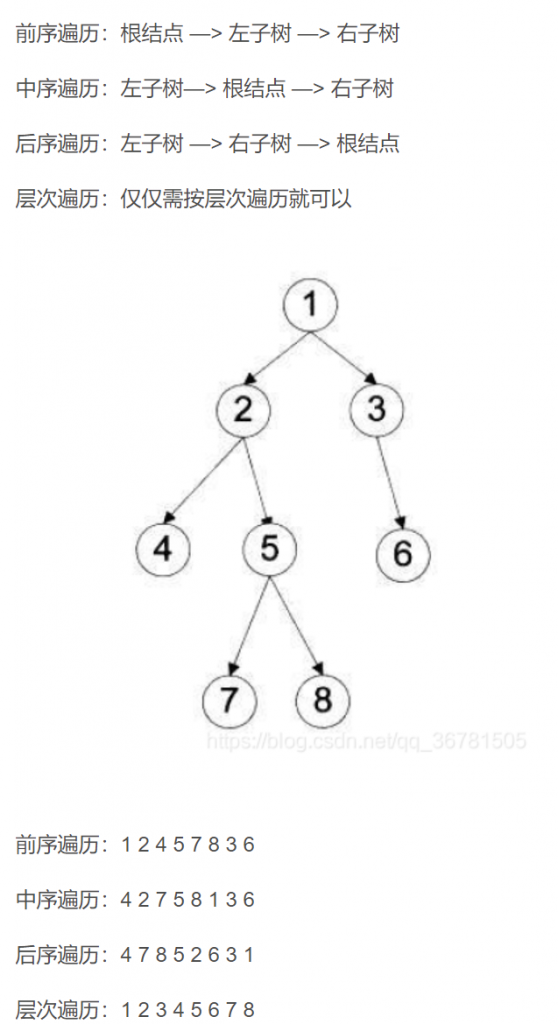用数组描述二叉树不太常用,数组描述是按满二叉树的编号记录数据,如果元素数目少的时候很浪费空间,一般还是用链表描述
首先定义节点,节点包括元素值和左右子树的指针。通常节点不包括指向父节点的指针,如有需要也可以添加
template<class T>
struct binaryTreeNode {//节点
T element;
binaryTreeNode<T>* leftChild, * rightChild;//左右子树
binaryTreeNode() { leftChild = rightChild = NULL; }//默认构造函数;
binaryTreeNode(const T& theElement) {//指定元素值的构造函数
element(theElement);
leftChild = rightChild = NULL;
}
binaryTreeNode(const T& theElement, binaryTreeNode* theLeftChild, binaryTreeNode* theRightChild) {//完整构造
element(theElement);
leftChild = theLeftChild;
rightChild = theRightChild;
}
};先不急着定义二叉树类,先看看四种遍历方法

前三种遍历通过递归算法都很容易描述,运用了栈的思想
template<class T>
void visit(binaryTreeNode<T>* x) {
cout << x->element << " ";
}
/*---------前序遍历------------------*/
template<class T>
void preOrder(binaryTreeNode<T>* t) {
if (t != NULL) {
visit(t);
preOrder(t->leftChild);
preOrder(t->rightChild);
}
}
/*--------中序遍历------------------*/
template<class T>
void inOrder(binaryTreeNode<T>* t) {
if (t != NULL) {
inOrder(t->leftChild);
visit(t);
inOrder(t->rightChild);
}
}
/*--------后序遍历------------------*/
template<class T>
void postOrder(binaryTreeNode<T>* t) {
if (t != NULL) {
postOrder(t->leftChild);
postOrder(t->rightChild);
visit(t);
}
}层次遍历复杂一些,需要逐层输出,用到了队列
/*-------层次遍历------------------*/
template<class T>
void levelOrder(binaryTreeNode<T>* t) {
arrayQueue<binaryTreeNode<T>*> q;//建立节点指针队列
while (t != NULL) {
visit(t);
//输出的同时把左右子树插入队列
if (t->leftChild != NULL)
q.push(t->leftChild);
if (t->rightChild != NULL)
q.push(t->rightChild);
try { t = q.front(); }
catch (queueEmpty) { return; }
q.pop();
}
}之后是二叉树类的完整定义
// linked binary tree using nodes of type binaryTreeNode
// derives from the abstract class binaryTree
#ifndef linkedBinaryTree_
#define linkedBinaryTree_
using namespace std;
#include <iostream>
#include "binaryTree.h"
#include "arrayQueue.h"
#include "binaryTree.h"
#include "myExceptions.h"
#include "booster.h"
#include "traverse.h"
template<class E>
class linkedBinaryTree : public binaryTree<binaryTreeNode<E> >
{
public:
linkedBinaryTree() { root = NULL; treeSize = 0; }
~linkedBinaryTree() { erase(); };
bool empty() const { return treeSize == 0; }
int size() const { return treeSize; }
E* rootElement() const;
void makeTree(const E& element,
linkedBinaryTree<E>&, linkedBinaryTree<E>&);
linkedBinaryTree<E>& removeLeftSubtree();
linkedBinaryTree<E>& removeRightSubtree();
void preOrder(void(*theVisit)(binaryTreeNode<E>*))
{
visit = theVisit; preOrder(root);
}
void inOrder(void(*theVisit)(binaryTreeNode<E>*))
{
visit = theVisit; inOrder(root);
}
void postOrder(void(*theVisit)(binaryTreeNode<E>*))
{
visit = theVisit; postOrder(root);
}
void levelOrder(void(*)(binaryTreeNode<E>*));
void preOrderOutput() { preOrder(output); cout << endl; }
void inOrderOutput() { inOrder(output); cout << endl; }
void postOrderOutput() { postOrder(output); cout << endl; }
void levelOrderOutput() { levelOrder(output); cout << endl; }
void erase()
{
postOrder(dispose);
root = NULL;
treeSize = 0;
}
int height() const { return height(root); }
protected:
binaryTreeNode<E>* root; // pointer to root
int treeSize; // number of nodes in tree
static void (*visit)(binaryTreeNode<E>*); // visit function
static int count; // used to count nodes in a subtree
static void preOrder(binaryTreeNode<E>* t);
static void inOrder(binaryTreeNode<E>* t);
static void postOrder(binaryTreeNode<E>* t);
static void countNodes(binaryTreeNode<E>* t)
{
visit = addToCount;
count = 0;
preOrder(t);
}
static void dispose(binaryTreeNode<E>* t) { delete t; }
static void output(binaryTreeNode<E>* t)
{
cout << t->element << ' ';
}
static void addToCount(binaryTreeNode<E>* t)
{
count++;
}
static int height(binaryTreeNode<E>* t);
};
// the following should work but gives an internal compiler error
// template <class E> void (*linkedBinaryTree<E>::visit)(binaryTreeNode<E>*);
// so the explicit declarations that follow are used for our purpose instead
void (*linkedBinaryTree<int>::visit)(binaryTreeNode<int>*);
void (*linkedBinaryTree<booster>::visit)(binaryTreeNode<booster>*);
void (*linkedBinaryTree<pair<int, int> >::visit)(binaryTreeNode<pair<int, int> >*);
void (*linkedBinaryTree<pair<const int, char> >::visit)(binaryTreeNode<pair<const int, char> >*);
void (*linkedBinaryTree<pair<const int, int> >::visit)(binaryTreeNode<pair<const int, int> >*);
template<class E>
E* linkedBinaryTree<E>::rootElement() const
{// Return NULL if no root. Otherwise, return pointer to root element.
if (treeSize == 0)
return NULL; // no root
else
return &root->element;
}
template<class E>
void linkedBinaryTree<E>::makeTree(const E& element,
linkedBinaryTree<E>& left, linkedBinaryTree<E>& right)
{// Combine left, right, and element to make new tree.
// left, right, and this must be different trees.
// create combined tree
root = new binaryTreeNode<E>(element, left.root, right.root);
treeSize = left.treeSize + right.treeSize + 1;
// deny access from trees left and right
left.root = right.root = NULL;
left.treeSize = right.treeSize = 0;
}
template<class E>
linkedBinaryTree<E>& linkedBinaryTree<E>::removeLeftSubtree()
{// Remove and return the left subtree.
// check if empty
if (treeSize == 0)
throw emptyTree();
// detach left subtree and save in leftSubtree
linkedBinaryTree<E> leftSubtree;
leftSubtree.root = root->leftChild;
count = 0;
leftSubtree.treeSize = countNodes(leftSubtree.root);
root->leftChild = NULL;
treeSize -= leftSubtree.treeSize;
return leftSubTree;
}
template<class E>
linkedBinaryTree<E>& linkedBinaryTree<E>::removeRightSubtree()
{// Remove and return the right subtree.
// check if empty
if (treeSize == 0)
throw emptyTree();
// detach right subtree and save in rightSubtree
linkedBinaryTree<E> rightSubtree;
rightSubtree.root = root->rightChild;
count = 0;
rightSubtree.treeSize = countNodes(rightSubtree.root);
root->rightChild = NULL;
treeSize -= rightSubtree.treeSize;
return rightSubTree;
}
template<class E>
void linkedBinaryTree<E>::preOrder(binaryTreeNode<E>* t)
{// Preorder traversal.
if (t != NULL)
{
linkedBinaryTree<E>::visit(t);
preOrder(t->leftChild);
preOrder(t->rightChild);
}
}
template<class E>
void linkedBinaryTree<E>::inOrder(binaryTreeNode<E>* t)
{// Inorder traversal.
if (t != NULL)
{
inOrder(t->leftChild);
linkedBinaryTree<E>::visit(t);
inOrder(t->rightChild);
}
}
template<class E>
void linkedBinaryTree<E>::postOrder(binaryTreeNode<E>* t)
{// Postorder traversal.
if (t != NULL)
{
postOrder(t->leftChild);
postOrder(t->rightChild);
linkedBinaryTree<E>::visit(t);
}
}
template <class E>
void linkedBinaryTree<E>::levelOrder(void(*theVisit)(binaryTreeNode<E>*))
{// Level-order traversal.
arrayQueue<binaryTreeNode<E>*> q;
binaryTreeNode<E>* t = root;
while (t != NULL)
{
theVisit(t); // visit t
// put t's children on queue
if (t->leftChild != NULL)
q.push(t->leftChild);
if (t->rightChild != NULL)
q.push(t->rightChild);
// get next node to visit
try { t = q.front(); }
catch (queueEmpty) { return; }
q.pop();
}
}
template <class E>
int linkedBinaryTree<E>::height(binaryTreeNode<E>* t)
{// Return height of tree rooted at *t.
if (t == NULL)
return 0; // empty tree
int hl = height(t->leftChild); // height of left
int hr = height(t->rightChild); // height of right
if (hl > hr)
return ++hl;
else
return ++hr;
}
#endif












Comments NOTHING